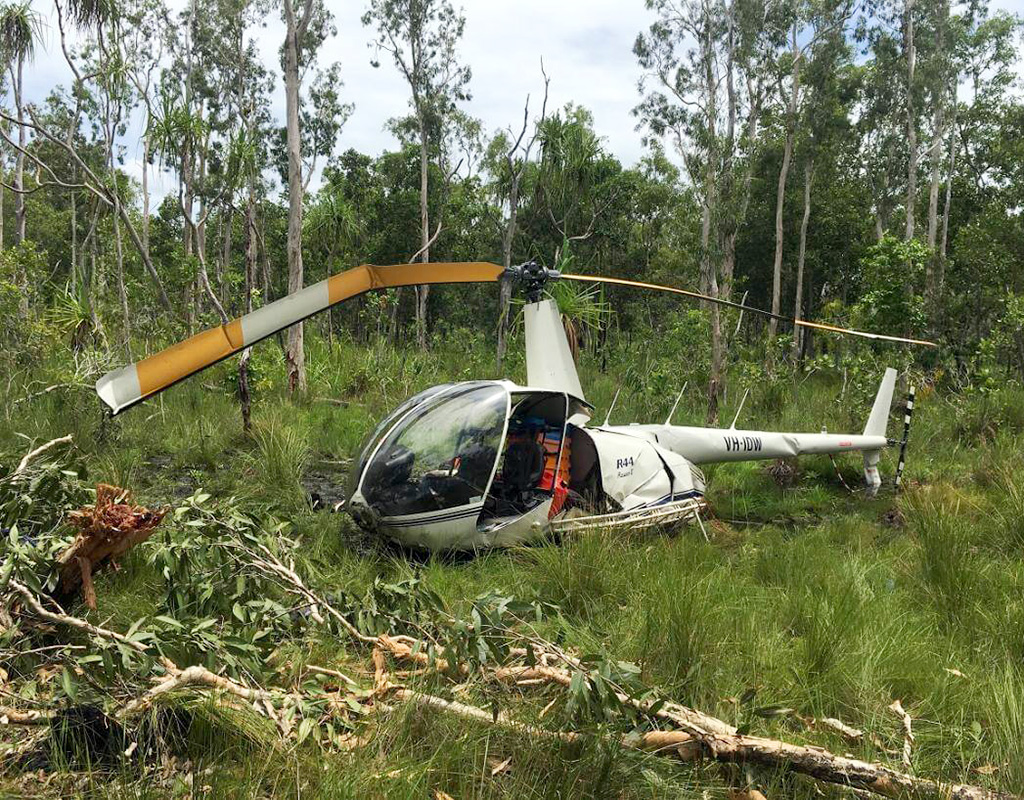
The Australian Transport Safety Bureau (ATSB) has released the final report from its transport safety investigation into an accident involving a Robinson R44 helicopter being used in the collection of crocodile eggs near the Northern Territory’s King River on Feb. 28, 2022.
The ATSB investigation determined that the helicopter’s engine stopped in flight, probably due to fuel exhaustion. During the subsequent autorotation emergency forced landing procedure, the pilot released the hooks and sling line carrying an egg collector beneath the helicopter.
The egg collector was released above a height that would likely be survivable, the investigation found. With insufficient main rotor energy to cushion the landing, the helicopter collided with the ground, and the pilot was seriously injured. The fatally injured egg collector was found on the ground wearing their harness and attached to the sling line.
“Based on an analysis of fuel samples and other evidence, the ATSB investigation found that the helicopter was likely not refuelled at a fuel depot about three quarters of the way between Darwin and the crocodile egg collecting area, and that the pilot did not identify the reducing fuel state before the helicopter’s engine stopped due to fuel exhaustion,” said ATSB chief commissioner Angus Mitchell.
“As such, this accident illustrates the importance of effective fuel management, which is especially critical when operating a helicopter where a fuel-related power loss offers few safe options.”
The investigation found that the operator was not using its safety management system to systematically identify and manage operational hazards.
“As a result, the operator did not adequately address the risks inherent in conducting human sling operations, such as carriage of the egg collector above a survivable fall height,” Mitchell said.
“In addition, and although not assessed on the evidence as having been contributory to this accident, the operator’s history of non-compliance with regulatory requirements, maintenance standards and accurate record keeping, increased the risk level for much of their aviation activities.”
At the regulator level, the egg collection was being conducted under an instrument issued to the operator by the Civil Aviation Safety Authority (CASA) that authorized the pilot to carry a sling person on a 100 foot line attached to the helicopter.
“The ATSB found that CASA did not have an effective process for assuring an authorization — the instrument issued to the operator — would be unlikely to adversely affect safety,” Mitchell said.
As a result, the ATSB could not find evidence that CASA delegates used the available structured risk management process to identify and assess risks; to ensure suitable mitigations were included as conditions of the instrument; and to assess the effects of changes on the overall risk.
This resulted in removal of the instrument’s mitigating conditions limiting the height, speed and exposure for the sling person, which permitted carriage of the egg collector above a likely-survivable fall height.
“At the operator and regulatory level, effective safety management processes that identify and safely manage hazards are vital to preventing future accidents,” Mitchell said.
“The ATSB notes that the operator has voluntarily ceased commercial helicopter operations, and welcomes that CASA has revised its documented regulatory exemption process, which should assure an adequate level of safety is achieved and documented when approving regulatory exemptions.
“Ultimately, this tragic accident highlights how the actions and decisions of pilots, operators and the regulator can all have a significant influence on aviation safety.”
Read the final report: Fuel exhaustion and collision with terrain involving Robinson R44 II, VH-IDW, King River, Northern Territory on 28 February 2022.

